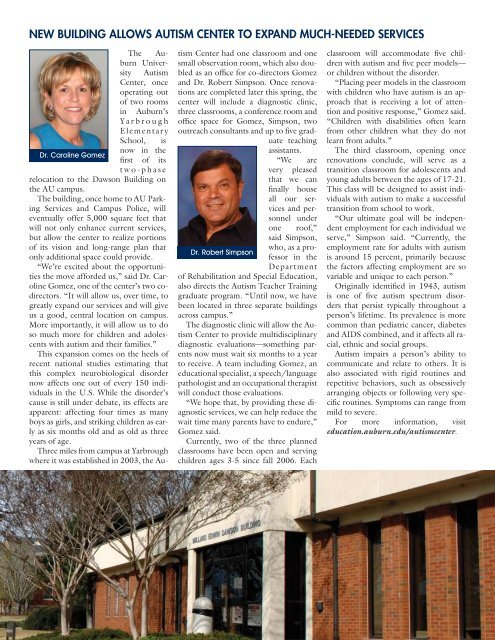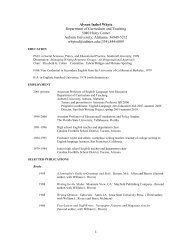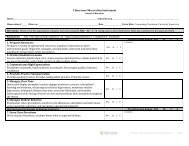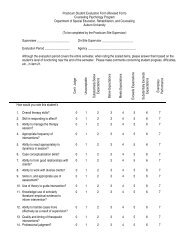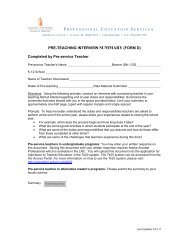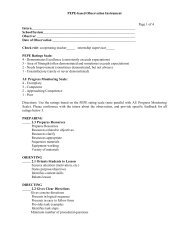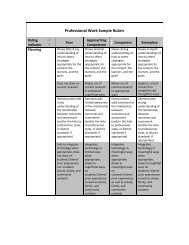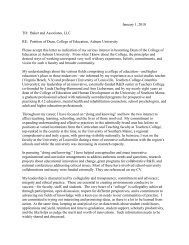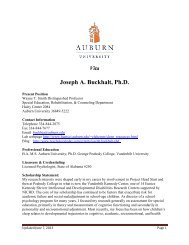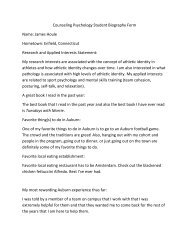teachers nationally whoachieved National BoardCertification in 2006.Dr. David Stodden, anassistant pr<strong>of</strong>essor in theSchool <strong>of</strong> Human Movement,Sport and LeisureStudies at Bowling Green(Ohio) <strong>University</strong>, is therecipient <strong>of</strong> the 2006National Association <strong>of</strong>Sport and Physical <strong>Education</strong>,Lolas HalversonOutstanding Young InvestigatorAward.Jenny Galimore <strong>of</strong> <strong>Auburn</strong>,Ala., was selected as2007 Teacher <strong>of</strong> the Yearby Yarbrough ElementarySchool (<strong>Auburn</strong>), whereshe teaches third grade.2003Rachel Adams is aK-12 vocational educationteacher in the ManateeCounty school systemin Bradenton, Fla.Kristen Britton is ateacher in the Huntsville(Ala.) City Schools system.Brian Burrows is the assistantdirector <strong>of</strong> LocalTransition Partnershipsfor the <strong>Auburn</strong> and OpelikaHigh Schools. Burrowsalso serves on Alabama’sSpecial <strong>Education</strong>Advisory Panel (SEAP)and the Youth LeadershipForum for Students withDisabilities (YLF) SteeringCommittee.Joshua Harry is a teacherin the Lee County (Ala.)Schools system. He residesin Valley, Ala.Dr. Candice H. Howard,an assistant pr<strong>of</strong>essor inthe Department <strong>of</strong> Kinesiologyand Health Promotionsat Troy <strong>University</strong>(Ala.), is the 2005-2006recipient <strong>of</strong> the IngallsAward for Excellence inClassroom Teaching, theuniversity’s most prestigioushonor for facultymembers.Kathryn Gwaltney Lemackis the director <strong>of</strong>operations for the NationalCenter for SportsSafety in Birmingham,Ala. The nonpr<strong>of</strong>it organizationeducates coacheson sports safety and howto stabilize an injuredathlete until a medicalpr<strong>of</strong>essional arrives.2004Dr. Regina Bentley is anassistant pr<strong>of</strong>essor in <strong>Auburn</strong><strong>University</strong>’s <strong>College</strong><strong>of</strong> Nursing. Also a registerednurse, her currentteaching areas includeobstetrical nursing, women’shealth, fundamentals<strong>of</strong> nursing, fundamentalsskill laboratory, and spiritualand cultural nursing.Tanya Ison Boone is ateacher in the ElemoreCounty (Ala.) SchoolSystem. She and herhusband, Kevin ’02 (Engineering),reside in Wetumpka,Ala.Lyndsey Estes <strong>of</strong> Tifton,Ga., is currently an occupationaltherapist. Shecompleted her master’sin occupational therapy atthe <strong>University</strong> <strong>of</strong> AlabamaBirmingham in 2006.Her interests include pediatricsand rehabilitation.Mary “Jan” PattersonBurkhalter is a teacherat Ogletree ElementarySchool in <strong>Auburn</strong>, Ala.She and her husband,Andrew ’03 (Business),reside in <strong>Auburn</strong>.Dr. LaLanya Ramsey <strong>of</strong>Phenix City, Ala., is principal<strong>of</strong> Russell CountyMiddle School in Seale,Ala.Amberlyn Frances Scottis a kindergarten teacherat Springville ElementarySchool in Springville, Ala.She and her husband,Chase, reside in Remlap,Ala. She is currently pursuinga master’s degree inearly childhood educationat the <strong>University</strong> <strong>of</strong> AlabamaBirmingham.2005Dr. Mandy Godfrey Conditis a school psychologistwith Clayton CountyPublic Schools in Morrow,Ga. She marriedPaul ’00 (Forestry) inApril 2005.Dr. Deirdre Cosper Greeris an assistant pr<strong>of</strong>essorand Early Childhood <strong>Education</strong>Program coordinatorin Columbus State<strong>University</strong>’s <strong>College</strong> <strong>of</strong><strong>Education</strong>, Department<strong>of</strong> Teacher <strong>Education</strong>.Dr. Necola “Nicole” Holiday<strong>of</strong> Montgomery, Ala.,is an associate pr<strong>of</strong>essor inthe Counselor <strong>Education</strong>program at Alabama State<strong>University</strong>. As an activemember <strong>of</strong> the AmericanCounseling Association,she is currently the divisionpresident and nationalmembership co-chair <strong>of</strong>Specialist in Group WorkDivision, the newslettereditor for the Marriageand Family Division, andthe awards chair for theMulticultural Counselingand Development Division.2006Dr. Mary Bartlett <strong>of</strong>Montgomery, Ala., receivedboth the IndividualPublication Award andthe Research Award atthe 2006 annual fall conference<strong>of</strong> the AlabamaCounseling Association(ALCA). She works parttime at GrandView BehavioralHealth Centers,and is an adjunction instructorat both Troy<strong>University</strong> Montgomeryand <strong>Auburn</strong> <strong>University</strong>Montgomery. A member<strong>of</strong> the Alabama suicidePrevention Task Force,Bartlett travels nationallyand internationally as aspeaker/trainer on suicideprevention for theAmerican Association <strong>of</strong>Suicidology.William Blake Busbin <strong>of</strong>Alpharetta, Ga., receivedone <strong>of</strong> 50 James MadisonFellowship awardednationally by the JamesMadison Memorial FellowshipFoundation <strong>of</strong>Washington, D.C. Thecompetitively awarded fellowship,directed towardcurrent and prospectiveteachers <strong>of</strong> American historyand social studies,supports graduate study<strong>of</strong> history and principles<strong>of</strong> the U.S. Constitution.Busbin is currently pursuinga master’s in secondarysocial sciences in theAU <strong>College</strong> <strong>of</strong> <strong>Education</strong>.Edward C. “Ted” H<strong>of</strong>fmanIII is the director <strong>of</strong>bands for the MadisonCounty (Miss.) Schoolssystem. He and his wifeNicole, a teacher alsoin the Madison CountySchools system, live inBrandon, Miss.Angela Homan is pursuinggraduate studies atDuke <strong>University</strong>.Andra Danielle Parrott,who currently teaches atBob Jones High Schoolin Madison, Ala., is therecipient <strong>of</strong> a $1,000New Teacher Grant fromthe Alabama Power CompanyService Organization.The selection committeeincluded educatorsand Service Organizationmembers.Jennifer Strekas is a seventh-gradeenrichmentteacher at Samford MiddleSchool in Opelika,Ala., where she and herhusband, Joshua, reside.She has been employedby eLearning Online, aninitiative <strong>of</strong> the AlabamaState Department <strong>of</strong><strong>Education</strong> and AlabamaPublic Television, to providequality pr<strong>of</strong>essionaldevelopment to teachersonline. She was part <strong>of</strong>the second cohort <strong>of</strong> Alabamateachers taking partin the training <strong>of</strong>feredthrough EdTech LeadersOnline.F R I E N D SIn Memoriam: CharlesM. Reeves Jr., husband<strong>of</strong> Dr. Frances SkinnerReeves ’71, passed away inNovember 2006. Reeves,a 1949 <strong>College</strong> <strong>of</strong> Businessgraduate who, alongwith his wife, was an avidsupporter <strong>of</strong> the <strong>College</strong><strong>of</strong> <strong>Education</strong>. The couple,long-time members <strong>of</strong> thePatrons <strong>of</strong> the Keystone/Dean’s Circle, establishedan endowed scholarshipin 2004 to honor Charles’mother and father—both<strong>of</strong> whom were <strong>College</strong> <strong>of</strong><strong>Education</strong> graduates.58 Building A Better Future for All education.auburn.edu
New building allows Autism Center to expand much-needed servicesThe <strong>Auburn</strong><strong>University</strong>AutismCenter, onceoperating out<strong>of</strong> two roomsin <strong>Auburn</strong>’sY a r b r o u g hElementar ySchool, isnow in thefirst <strong>of</strong> itst w o - p h a s erelocation to the Dawson Building onthe AU campus.The building, once home to AU ParkingServices and Campus Police, willeventually <strong>of</strong>fer 5,000 square feet thatwill not only enhance current services,but allow the center to realize portions<strong>of</strong> its vision and long-range plan thatonly additional space could provide.“We’re excited about the opportunitiesthe move afforded us,” said Dr. CarolineGomez, one <strong>of</strong> the center’s two codirectors.“It will allow us, over time, togreatly expand our services and will giveus a good, central location on campus.More importantly, it will allow us to doso much more for children and adolescentswith autism and their families.”This expansion comes on the heels <strong>of</strong>recent national studies estimating thatthis complex neurobiological disordernow affects one out <strong>of</strong> every 150 individualsin the U.S. While the disorder’scause is still under debate, its effects areapparent: affecting four times as manyboys as girls, and striking children as earlyas six months old and as old as threeyears <strong>of</strong> age.Three miles from campus at Yarbroughwhere it was established in 2003, the AutismCenter had one classroom and onesmall observation room, which also doubledas an <strong>of</strong>fice for co-directors Gomezand Dr. Robert Simpson. Once renovationsare completed later this spring, thecenter will include a diagnostic clinic,three classrooms, a conference room and<strong>of</strong>fice space for Gomez, Simpson, twooutreach consultants and up to five graduateteachingassistants.“We arevery pleasedthat we canfinally houseall our servicesand personnelunderone ro<strong>of</strong>,”said Simpson,who, as a pr<strong>of</strong>essorin theDepartment<strong>of</strong> Rehabilitation and Special <strong>Education</strong>,also directs the Autism Teacher Traininggraduate program. “Until now, we havebeen located in three separate buildingsacross campus.”The diagnostic clinic will allow the AutismCenter to provide multidisciplinarydiagnostic evaluations—something parentsnow must wait six months to a yearto receive. A team including Gomez, aneducational specialist, a speech/languagepathologist and an occupational therapistwill conduct those evaluations.“We hope that, by providing these diagnosticservices, we can help reduce thewait time many parents have to endure,”Gomez said.Currently, two <strong>of</strong> the three plannedclassrooms have been open and servingchildren ages 3-5 since fall 2006. Eachclassroom will accommodate five childrenwith autism and five peer models—or children without the disorder.“Placing peer models in the classroomwith children who have autism is an approachthat is receiving a lot <strong>of</strong> attentionand positive response,” Gomez said.“Children with disabilities <strong>of</strong>ten learnfrom other children what they do notlearn from adults.”The third classroom, opening oncerenovations conclude, will serve as atransition classroom for adolescents andyoung adults between the ages <strong>of</strong> 17-21.This class will be designed to assist individualswith autism to make a successfultransition from school to work.“Our ultimate goal will be independentemployment for each individual weserve,” Simpson said. “Currently, theemployment rate for adults with autismis around 15 percent, primarily becausethe factors affecting employment are sovariable and unique to each person.”Originally identified in 1943, autismis one <strong>of</strong> five autism spectrum disordersthat persist typically throughout aperson’s lifetime. Its prevalence is morecommon than pediatric cancer, diabetesand AIDS combined, and it affects all racial,ethnic and social groups.Autism impairs a person’s ability tocommunicate and relate to others. It isalso associated with rigid routines andrepetitive behaviors, such as obsessivelyarranging objects or following very specificroutines. Symptoms can range frommild to severe.For more information, visiteducation.auburn.edu/autismcenter.education.auburn.edu Keystone • Volume IV, 2007 59


